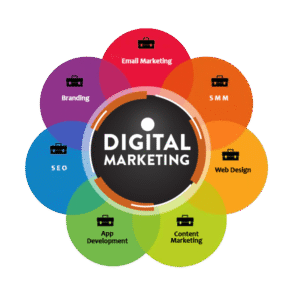How it works

Digital marketing is promoting products or services using digital devices and technology. In simple terms, it’s any form of marketing that happens online, utilizing tools like smartphones, laptops, the internet, and social media platforms.
For example, a company might run targeted Facebook ads, optimize its website for search engines (SEO), or engage customers through email campaigns to increase brand awareness and drive sales. The goal is to promote products and build a strong online presence, enhance customer engagement, and boost conversions through tailored strategies.
Importance of Digital Marketing
Once you’re clear on what digital marketing is, the next step is understanding its value and importance. The importance of digital marketing is immense! Unlike traditional marketing, which is constrained by geographical limitations, digital marketing provides a platform for businesses to connect with potential customers worldwide. Small companies and startups can now compete with the bigger players. Digital marketing enables precise targeting, ensuring marketing efforts are directed toward a very specific demographics, interests, and behaviors, thereby increasing the ROI.
Benefits of Digital Marketing

-
Cost-effective
Digital marketing is one of the most cost-effective forms of marketing. Compared to traditional marketing and advertising methods like TV ads or print ads, digital marketing can be an affordable way for small businesses to reach a large audience without having to spend a fortune. That makes it an especially appealing choice for startups seeking to do more with marketing capital.
-
Customer Engagement
With digital marketing, businesses have the opportunity to interact with customers in real-time. Whether its social media marketing, email, or online platforms, they can engage directly with their audience. Such interactions can lead to more personalized experiences for consumers while also developing a greater sense of community around brands.
What is Digital Marketing Strategy and How to Create One
A modern digital marketing strategy is a detailed plan that helps businesses achieve their marketing goals by leveraging digital platforms. Creating a successful strategy requires a combination of planning, analysis, and execution across multiple digital channels.
Here’s a step-by-step guide to help you establish a robust digital marketing strategy:
Step 1: Define Your Goals
Start by setting clear, specific, and measurable goals. Whether you aim to increase website traffic, generate more sales, or enhance brand awareness, defining your objectives will help direct the overall strategy and keep you focused.
Step 2: Identify Your Target Audience
Knowing your audience is key to guiding your content, messaging, and strategy. Establish key demographics (age, location, interests, etc.) and discuss their behaviors and preferences in more detail. With this knowledge, you can create custom experiences that connect with your audience.
Step 3: Perform a Competitor Analysis
Research your competitors’ digital presence to identify what they’re doing well and where they’re lacking. Analyze their websites, social media activity, content strategies, and ad campaigns. This will provide valuable insights and highlight areas where you can differentiate your business.
Step 4: Select Digital Marketing Channels
You should choose the channels that are effective for your target audience. Search engines, social media platforms, email marketing, or content marketing, target the channels your audience is most active at. Customize your plan for the uniqueness of each platform.
Step 5: Develop a Content Strategy
Content is the backbone of any digital marketing effort. Plan how you will create and distribute content that appeals to your target audience. This could include blog posts, videos, infographics, or social media content. Ensure your content aligns with your business goals and provides value to your audience.
Step 6: Set a Budget
Decide what you’re ready to spend on digital marketing. The level you choose will help determine what resources, tools and strategies will be available to you. Budget for content creation, paid advertising, SEO, content marketing tools, etc.
Step 7: Execute SEO Strategy
This involves doing keyword research, optimizing on-page SEO components (such as titles, meta descriptions, and headers), and obtaining links from reputable sites. SEO is also key to long term visibility.
Step 8: Optimize Your Web Pages
Ensure your web page is fast-loading, mobile-friendly, and easy to navigate. These little things make a difference between an optimized page and a non-optimized page. A properly optimized page will lead to a better user experience, reduced bounce rates, and, ultimately, more conversions.
Step 9: Measure and Adjust
Use tools like Google Analytics and social media insights to track your campaigns’ performance. Regularly assess what’s working and what’s not, and be prepared to adjust your strategy. Analyzing your data will help you optimize campaigns and achieve better results over time.